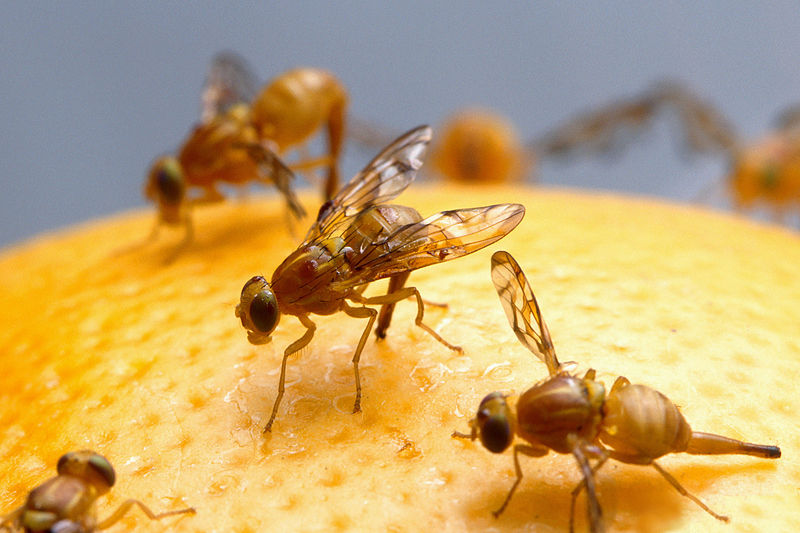Anastrepha ludens
Mexican Fruit Fly
Synonym(s):Acrotoxa ludens, Trypeta ludens, Anastrepha lathana
Class: Insecta
Order: Diptera
Family: Tephritidae

Photographer: Jack Dykinga, USDA
Source: http://www.insectimages.org/browse/detail.cfm?imgnum=1322089
Description
Adult Description: Most Anastrepha species are characterized by their yellow to brown body, wing coloration and distinctive wing pattern. The Mexican fruit fly is slightly larger than a house fly. Female Mexican fruit flies have an especially long ovipositor, which is used to deposit eggs.
Host Plant: Any plant or tree that is fruit-bearing such as: Peach, grapefruit, orange, pear, avocado, apple, and mango.
Ecological Threat: Since the Mexican Fruit Fly lays their eggs inside of fruit, the larvae growth and feed within the fruit and destroy it. This is a major issue since the eggs are laid in fruit like apples, peaches, avocados and mango which are very important crops for the United States, Mexico and Central America.
Biology: Adult Mexican fruit flies can live up to eleven months in ideal conditions. A single female can lay up to 1500 eggs in her lifetime either singly or in groups up to 18 in one fruit. Females will use their ovipositor to deposit eggs underneath the skin of a fruit that is beginning to show color. In six to twelve days, the eggs hatch and the larvae burrow further into the fruit. At this stage, the larvae take on the color of the fruit that they are in which makes them easy to overlook. Larvae development can take anywhere from 11-35 days. Once mature, the larvae leave the fruit and burrow into the soil below to pupate. Reproduction occurs year-round, with four to six generations occurring. When the adults emerge, they will be able to reproduce in 8-34 days.
History: There have been 13 recorded plant hosts for the Mexican fruit fly allowing it to invade nearby United States with similar climates and crops found in Mexico. In 2003, live larvae were found in Pinellas County Florida, in manzano peppers that originated from Mexico. However, the discovery of adults in Florida has been surprisingly rare. Mexican fruit flies have been a pest for the Southern counties of Texas that are along Mexico’s border.
U.S. Habitat: The Asian Gypsy moth can be found in a variety of forested areas where the host plants are found. With such a large range of host plants the Asian gypsy moth is not limited by availability of resources.
Distribution
Native Origin: Mexico and Central America, as far south as Costa Rica.
U.S. Present: AZ, CA, FL, TX
Management
Egg and larval stages inside the fruit are safe from insecticidal treatments. The adult stage is susceptible to control, usually by short-lived bait comprised of a contact insecticide mixed with protein and carbohydrate. This is applied as fine droplets to host plant foliage where adults feed. Removing all infested or fallen fruits immediately and destroying them can considerably reduce fly population densities. People should not bring any fruit, plants, or vegetables from outside of the US without clearance from agriculture inspectors. The method is different on a large-scale system like an orchard. If a fly is trapped in an orchard, then all fruit from that orchard is quarantined for two weeks. If a second wild fly is found then the quarantine is extended for a year.
In January 2012, the USDA-APHIS announced that the Mexican fruit fly was eradicated from the last county in Texas in which it had been present. Unless introduced again from overseas or Mexico, this means the United States is temporarily free of Mexican fruit flies
Text References
Clark RA, Steck GJ, Weems Jr HW. 1996. Detection, quarantine, and eradication of exotic fruit flies in Florida, pp. 29-54. In D.L. Rosen (editor), Pest Management in the subtropics: Integrated pest management - a Florida perspective. Intercept Ltd. Andover UK.
Dickens J.C., Solis E and W.G. Hart. 1982. Sexual development and mating behavior of the Mexican fruit fly, Anastrepha ludens (Loew). The Southwestern Entomologist 7: 9-15.
Ebeling W. 1959. Subtropical Fruit Pests. University of California, Division of Agricultural Science 436 pp."fruit fly." The Columbia Encyclopedia, 6th ed.. 2012. Encyclopedia.com. 31 Aug. 2012
Hernandez-Ortiz V. 1992. El genero Anastrepha Schiner en Mexico (Diptera: Tephritidae), Taxonomia, distribucion y sus plantas huespedes. Instituto de Ecologia, Xalapa Mexico. 162 pp.
NAPPO. (January 2012). Anastrepha ludens (Mexican fruit fly) eradicated in the United States. Phytosanitary Alert System. http://www.pestalert.org/oprDetail.cfm?oprID=511 (18 January 2012).
Robacher D, Magan RL. 1993. ARS Program on Anastrepha species to meet APHIS Plant Quarantine requirements. University of Florida seminar.
White I.M. and M.M. Elson-Harris. 1994. Fruit Flies of Economic Significance: Their Identification and Bionomics. CAB International. Oxon, UK. 601 pp.
Internet Sources
http://www.invasivespeciesinfo.gov
 Texas Invasive Species Institute
Texas Invasive Species Institute